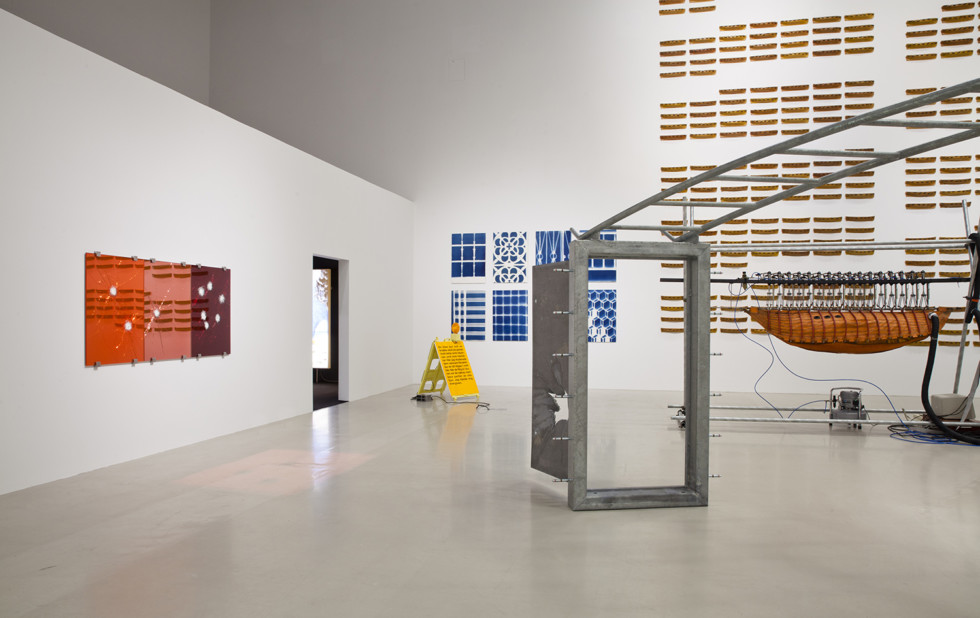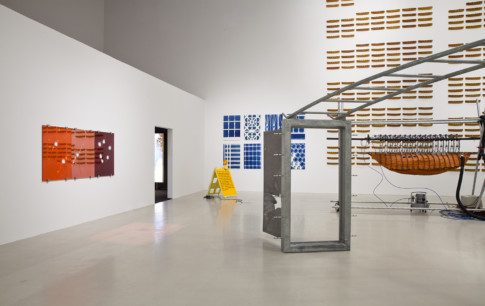
Installation view Ulf Rollof: Urgent, Moderna Museet Mamlö Photo: Helene Toresdotter/Moderna Museet
In-depth
Angel Trap (1984)
Ulf Rollof’s oeuvre revisits the subject of borders frequently. The border between the organic and the artificial, between humans and animals, rationality and occultism, and the man-made borders between nations.
Machines to capture spiritual beings are tools that we humans could relate to rationally. Angel Trap highlights the duality in Rollof’s artistic practice – on the one hand, an inexorable faith in invisible, spiritual forces; and on the other, the human faith in technological progress. At first glance, Angel Trap looks like a landing strip, as though its purpose is to help angels approach humanity. But on closer inspection, it becomes obvious that this is after all a trap.
Después del 19.9.1985. (1985)
In 1985, Ulf Rollof made his second visit to Mexico, travelling around large parts of the country on his own for five months. During a short sojourn in the USA with a friend, he heard that Mexico City had been hit by a devastating earthquake on the morning of September 19th, 1985.
They returned to the Mexican capital after a nine-day bus journey through the desert. The aftermath of the disaster affected Rollof deeply, and he wandered the city at night, documenting everything he saw in drawings, photographs and writing. The series Después (Afterwards) is a reflection on how the city had changed, since the earthquake and since Rollof’s previous visit. By venturing in among the ruins and confronting the events with his physical presence, Rollof attempted to relate to the reality of the disaster.
Mexico is located within the Ring of Fire, a string of volcanoes and sites of seismic activity around the Pacific Ocean. This means that volcanic eruptions and earthquakes occur regularly. The border between Mexico and the USA is largely defined by the Rio Grande River. Mexico’s geopolitical location augurs disaster.
Refrigeration Coat (1989)
Thermal Sun (1989)
Ulf Rollof’s two works Refrigeration Coat and Thermal Sun manifest his interest in relationships between two extremes, between two mutually dependent components, that are nevertheless a mutual threat. Refrigeration Coat is a wearable mechanical cooling system, an opportunity for insulation and isolation. Thermal Sun, is an artificial sun that generates heat. Their relation gives rise to a zero-sum game that inspires hope and despair, where the link between man and nature is presented as both cause and effect. Man’s futile attempts to harness natural forces and resources is a recurring element in Rollof’s oeuvre. He stretches the boundaries and creates polarities. No given “good” or “evil” emerges from this constellation of elements, but a clarification of the underlying forces.
In many ways, both works are an extension of the series titled Dormimundo, which, in turn, was based on Rollof’s experiences from the earthquake in Mexico City compared to the tranquil village of San Bartolo Pareo in Michoacán. Rollof went to live in this remote location just after the debris from the earthquake had been cleared. When he moved there in the winter 1985-86, the only accommodation available for rent was a simple windowless cabin. In contrast to the total darkness inside the cabin, the midday sun glowed in the sky outside the door.
Lifeboat (1990)
Ulf Rollof’s large installation Lifeboat consists of three parts, of which two are shown in the exhibition. In 1986, Rollof began to study bellows and their potential to suck in spirits. Rollof had personally caught sight of a seated figure on a visit to the town Edsbyn (Sweden) in 1983. In Lifeboat, we encounter two large bellows that appear to breathe calmly and mechanically, and where one gives air to the other. The second part of the work consists of 365 wall-mounted lifeboats, made of synthetic wax, blackberries, latex and cotton. The method of preserving blackberries in rubber is something Rollof learned in Mexico, where he also learned how to extract rubber from trees.
Together, the elements of the installation suggest ideas of resurrecting and preserving life, either mechanically or naturally, without pitching the two methods against each other. On the contrary, they are perhaps equated.
It should be mentioned that this work was initially created for an exhibition at the Sveaborg fortress outside Helsinki, the construction of which began in 1748, and which was used to defend Sweden’s eastern parts. The entire installation can be seen as a keeper of time, both past and future, and a link between the material and the immaterial.
Abandonado II (1992)
The encounter with the social catastrophes on the border between the USA and Mexico made a profound impression on Ulf Rollof. Tijuana is the northernmost city on the west coast of Mexico. Many people try to cross the border into the US illegally at night. Some succeed, while others are sent back to Tijuana, making the city a form of limbo for those waiting to attempt the ordeal anew.
In 1992, Rollof returned to the border for a new collaboration with Michael Schnorr. Where the series Después del 19.9.1985 and Dormimundo reflect on the effects of a natural disaster, the works in Abandonado II focus on a social catastrophe. Together with Schnorr, Rollof built an installation on a vacant lot in Playas, Tijuana. In practice, this lot was the last corner of Latin America, since it is Mexico’s last piece of land (30 m from the border) along the Pacific coastline. The earth was dug up and shaped to emulate the map of Baja California.
During the construction process, Rollof noticed that the site was beginning to resemble a park, which made clear what his artistic contribution should look like. The installation consisted of benches and school desks made of bricks that can be heated – like chimneys. For Rollof, the warmed-up furniture was intended as protection, in the absence of a roof, for the people waiting every night. Rollof intended Fire Chair – a heated recliner – as a warm and comfortable place from which to observe the surrounding chaos while being enveloped in the cool Pacific breeze.
Many children are abandoned in Tijuana when their parents try their luck at attaining the “American Dream”. According to Rollof, these are the worst victims of the situation which is why he also built school desks. Abandonado is the Spanish word for “abandoned”.
Calendar II (2000)
Calendar II consists of 114 watercolours mounted with magnets on the wall. Some of them are covered by a transparent plastic film with printed text. The colour scheme is limited to shades of ochre, and the paintings look like they were executed with light brush strokes, giving the motifs an immediate and transient appearance. Together with the title, the seriality of this work testifies to Ulf Rollof’s constant interest in time and movement. The subject matter (people together, organic shapes, phalluses, breasts, etc) and the text fragments (references to “cave”, “house”, and the spreading of polyps) suggest thoughts of a creation myth – or rebirth – where man and nature are in a closely symbiotic relationship, which is at once both fertile and evanescent.
Table II (2007)
Table II is a clinically sterile staging of an operating theatre. An operating table stands under a large light, while a greenish surgical cloth is hung on one wall with strip lighting behind it. On the table lies a construction made of chrome-plated copper, resembling a ribcage, where the spine is rendered even more inhuman by the pipes running through the table and ending in a bowl. A safety belt on the table, together with the formal and clean setting, add to a menacing feeling of helplessness, where the hope that the surgery will lead to something better also demonstrates the patient’s obvious vulnerability in such a situation. The presentation resembles something from a near future, where the cold precision of the design also erases and drains the humanity that is under scrutiny.
Egg Ring With Eggs Out (1998)
Ulf Rollof lived in New York as a recipient of a IASPIS residency in 1996-1997. In the midst of this metropolis, where everything can be perceived as artificial, he missed being in touch with nature. Grocery stores offered something that brought memories of nature, at the same time as being its opposite due to mass-production. By working with eggs, Rollof attempted to return to the beginnings and, as many times before in his practice, find a new starting point. The egg as the origin of life.
Fragility and strength, life and death, nature and artifice, these dualities are forever in dialogue in Rollof’s works and are conspicuous in the Egg Ring series. The egg symbolises life’s potential, and Rollof sees the yolk as pure magic – containing not only life, but the potential to fly. Those who fly, be they birds or spirits, are a recurring theme in Rollof’s oeuvre, intertwining works such as Egg Ring (1998), Bellows (1990), and Angel Trap (1984).
The rings in Egg Ring are straight-forward, elegant, mathematical solutions, where simple materials such as steel, wax, and wood converse with eggs. Inside, however, these eggs do not have the prospect of life; they are empty, dead, and thus, a mere illusion.

